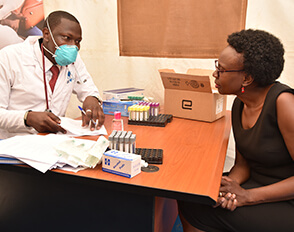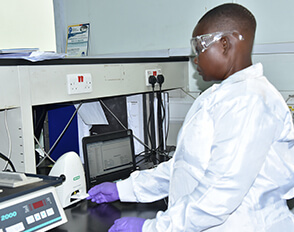Citizen Science: the simple participating in complex matters of scientific research to better their health.
IDI established DataFax unit in 2009. This is in line with its mission to build capacity of health systems for the delivery of sustainable, high quality care and prevention of HIV/AIDS and related infectious diseases through training, research and advanced clinical services.
IDI, as a centre of excellence, needed a system to produce quality, timely and reliable data arising from its research activities. Essentially, the quality of research depends highly on the quality of the data produced.
A number of studies have been completed successfully and many more are being setup to benefit from this efficient system at IDI. A door was opened for other non-IDI studies, especially those carried out in developing countries where the quality of data may limit excellence in research, to also benefit from this unit.
IDI is both an academic and a non-profit making organization, and therefore, it only charges a small fee to other collaborators who are interested in using the system to allow sustainability of the system and the unit.
IDI is grateful to NIH-Uganda ICER and OCICB/NIAID/NIH for the efforts in the unit establishment and the continued technical support.
DataFax is now DFdiscover!
What is DFdiscover?
Client-server application.
Hybrid Paper Fax and Electronic Data Capture (EDC) system
21 CFR Part 11 compliant
- System validations
- Electronic signatures
- Password aging, reuse, complexity, and lockout
- Audit trails
Completed CRFs are transmitted from remote clinical sites to DFdiscover server using a Fax machine or using the Dfsend tool or as an email attachment in pdf or TIFF format.
A computer running DFdiscover system retrieves the faxed CRFs, indexes them and the DFdiscover Intelligent Character Recognition (ICR) software scans each CRF and reads off the data fields to create a record for human review.
Data staff review the record against the CRF image in a split-screen view to correct any ICR errors and complete character fields before saving the record as either clean, dirty or pending.
DFDiscover Components
DFcollect online/offline solutions open the door to tablet based remote data collection without custom app provisioning. Data entry, query review and supplementary document management are all possible with DFcollect’s intuitive tablet interface. DFcollect works online, and is equally capable offline, making collected data immediately available for central review after connectivity is restored.
DFexplore
The Data entry screen in our DFexplore desktop application looks identical to the CRF. EDC screens can be designed to match the CRFs and source documents, making monitoring more efficient.For paper-based trials or forms, the EDC screen and the scanned CRF can be seen side-by-side. DFdiscover tracks all revisions of the forms, so if the site changes any data, they can simply initial and date the change on the paper following GCP, and re-scan. DFdiscover tracks it all, and all versions are available for review.
DFweb leverages your existing browser and brings the power of DFdiscover to the desktop, without installing an application. eCRFs are presented in a familiar subject binder view. Designed for fast/accurate data entry, DFweb includes tools to streamline data collection, query creation, and review. DFweb presents the same data that is managed at the central site, adding the power and simplicity of a web browser interface. Like DFexplore and DFcollect, no customization is needed – simply enable and deploy, using the same study definition.
Why DFdiscover?
- Reduce Data processing time – Real-time data capture via DFexplore or faxing of CRFs, immediate fax processing by the computer, assisted review of CRFs, integrated document imaging and data management systems. Real-time querying of sites.
- Improve quality control – Easier to identify problems with use of QC notes, QC reports, identification of re-faxed CRFs and possibility of comparing database records against CRFs using DFexplore.
- CRF Imaging, Storage and Retrieval – Paper CRFs remain at the site, any corrections are made to the original CRFs, faxed images are stored on the DFdiscover server at National Institute of Health in Bethesda, and can be saved as PDF files and archived, multiple images can be retrieved to trace changes over time.
- Access control to data records – User access rights to the database can be programmed on an individual user basis.
Other reasons include:
- Remote site monitoring
- Does not rely on constant electricity and internet at the site
- Patient scheduling and tracking
- Full Audit trail
- Standardized reports
- Interface to SAS, ORACLE, MYSQL, and PostgreSQL
- QC/QA of data on an ongoing basis
- Handle data from multiple sites subject to similar quality control measures
- Fast data entry with the help of an embedded Intelligent Character Recognition (ICR) system – > 350 records per day per person
- Remote access to original source documents
- Rapid feedback on errors
- Meets FDA regulations, GCP & ICH guidelines
- Provides clean data soon after study completion
- Not everybody at the clinical sites is in love with computers
Our Services
- Case Report Form (CRF/eCRF) design and development
- Database development and maintenance
- Edit Check programming
- Multi-language support
- Data Management Plan
- CRF completion guidelines
- Managing Lab normals
- CDISC standards
- Data cleaning
- Tables, Listings and figures
- Randomisation Schema
- Medical coding
- Database lock and archive
Our current partners
- Centers for Disease Control and Prevention(CDC)
- National Institutes of Health(NIH)
- JOHNS HOPKINS UNIVERSITY(JHU)
- UNIVERSITY OF ANTWERP(UAntwerp)
- St George’s University of London(SGUL)
- University of Minnesota(UMN)
- University of Liverpool(UoL)
- University of Zurich(UZH)
- College of health sciences, Makerere University
- African Field Epidemiology Network (AFENET)
DataFax Sites
What Principal Investigators say about DataFax/DFdiscover
The IDI DataFax team is very professional and offers superb service. Ultimately, it’s using technology to be more efficient. DataFax has lower cost than hiring a data entry clerk to manually type in the data, and the advantages are astronomically better.
David R. Boulware, M.D., MPH, CTropMed – PI COAT & NOAT
The DataFax system is a breath of fresh air in the management of massive data arising from clinical studies like ours. The system ensures that; 1) we are not dealing with human errors in the abstraction of our data from CRFs, 2) our data is available in a timely manner and 3) it’s easier to conduct pre-analysis data checks to confirm the validity of our data.
Amara Ezeamama-Onye, PhD – Co-PI TOV
Because of the impressive DataFax system – a system we are using to manage, input and store data related to the trial – the trial database will be maintained in real time. I, as an external monitor, can log into the system and check for inconsistencies at home, at any time. That makes life a bit easier.
Angela Colbers -Trial Monitor – DOLPHIN Study
Figures
10 years of existence
30 closed studies
15 active studies
9 well trained staff
12,000 records processed per months
Contact Us
Dr. Agnes Kiragga
Head of Statistics and data management
Infectious Diseases Institute
Makerere University
E-mail: akiragga@idi.co.ug
Office Tel: 0312307327
Mob: +256772512026
Betty Agwang
Team Lead
Infectious Diseases Institute
Makerere University
E-mail: bagwang@idi.co.ug
Office Tel: 0312307327
Mob: +256782282765
Email Us






